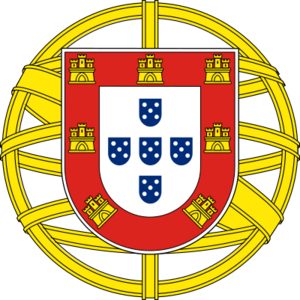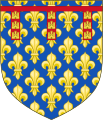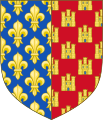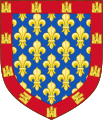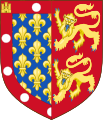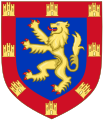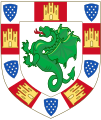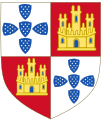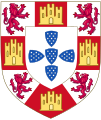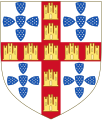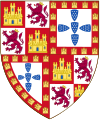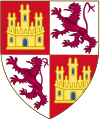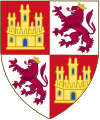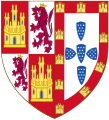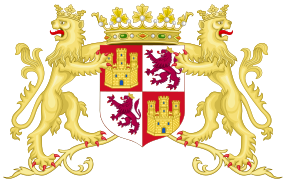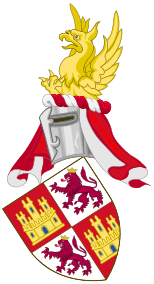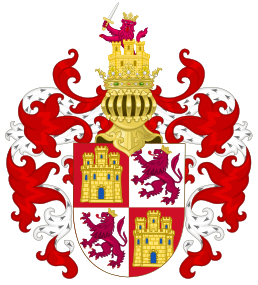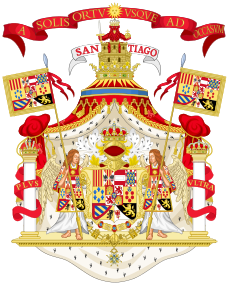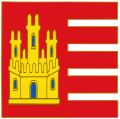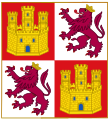Heraldry of Castile facts for kids
The coat of arms of Castile was the special symbol of its kings and queens. These symbols helped people identify the ruler and showed who belonged to the kingdom. Over time, they also came to represent the feeling of being part of a nation or territory.
The official description (called a blazon) of the Castile arms is:
Gules a triple-towered castle Or masoned Sable and ajoure Azure.
This means: a red background (Gules) with a gold (Or) castle that has three towers. The castle's stones (masoned) are black (Sable), and its windows and doors (ajoure) are blue (Azure).
Contents
How the Castle Symbol Started
The Royal Arms of Castile first appeared around 1175. This was when heraldry, the system of using special symbols for families and kingdoms, became popular across Europe. Before King Alfonso VIII's rule, there isn't much proof of a fixed symbol for Castile.

King Alfonso VIII started using a special seal in 1165. At first, his seals showed a cross or an image of him on horseback. The castle symbol first appeared on the back of his hanging seals. The oldest known seal with the castle is from 1176. Experts believe the castle symbol was likely chosen in 1169, when Alfonso VIII turned 14 and became old enough to rule on his own.
The castle was chosen to represent the land of Castile. This is an example of "canting arms," where the symbol sounds like or looks like the name (Castile sounds like "castle"). This choice might have also shown that the King of Castile wanted to be seen as more powerful than the King of León.
The castle design has stayed pretty much the same since the beginning: three towers, with the middle one taller than the two on the sides. This suggests it was a unique idea from Castile, different from castle symbols used in other parts of Europe.
Colors of the Arms
The colors of the arms – a gold castle on a red background – were set by the time King Ferdinand III (known as "the Saint") ruled. These colors might have been inspired by the arms of King Alfonso VIII's wife, Eleanor of England. Eleanor was the daughter of Henry II. Her family's arms, the Royal Arms of England, had three gold lions on a red background. These were very old and easily recognized symbols.
Since Alfonso VIII and Eleanor married between 1170 and 1176, this timing fits with when the castle symbol and its colors were adopted. Another reason for choosing gold and red is that these colors were often used together in heraldry. The blue color for the castle's doors and windows was likely chosen because it looked good with the gold and red, or because blue was the third most common color used in heraldry.
At first, the castle symbol was often used on its own, not always inside a shield. You can see this on the tomb of Alfonso VIII and Queen Eleanor in the Abbey of Santa María la Real de Las Huelgas. The tomb has both the castle symbol and the English arms on a shield. The castle also appeared on all Castilian coins of that time.
How the Castle Symbol Spread
Even though King Alfonso VIII didn't have any sons who lived to rule after him, the Royal Arms of Castile spread through his daughters' families. This included royal families in Portugal, Aragon, and France.
The Castilian castle appeared in the symbols of almost all of Alfonso VIII's grandchildren. For example, the children of Louis VIII of France and Queen Blanche used the gold castles on a red background in their shields.
A very important example of the castle spreading is in Portugal. When Afonso III became king, he added a red border with castles to the Portuguese royal arms. This design stayed part of Portugal's national symbol until 1910, and it's still part of the national coat of arms today.
France
-
Arms of Robert I, Count of Artois
-
Arms of Alphonse, Count of Poitiers
-
Arms of Charles I of Anjou
(until 1246) -
Arms of Alphonso of Brienne
Portugal
-
Arms of Beatrice of Portugal
(As disputed Queen of Portugal)
Combining with the Arms of León
In 1230, King Ferdinand III united the Kingdom of Castile and the Kingdom of León. To show this new union, he combined their symbols on one shield. This is called "quartering," where the shield is divided into four sections. He put the Castilian arms (the castle) in the top-left and bottom-right sections, and the Leonese arms (a lion) in the other two. This way, the symbol clearly showed that the two kingdoms were now one. This method of combining symbols became very popular across Europe.
The quartered arms of Castile and León were used by Castilian kings and queens until the time of the Catholic Monarchs. These symbols continued to represent the Crown of Castile until 1715.
Spanish Monarchy and Today's Uses
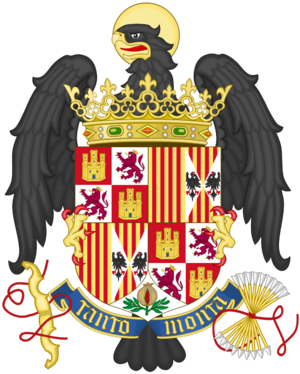
In 1475, Isabella of Castile and Ferdinand II of Aragon married, uniting the Crowns of Castile and Aragon. They combined their symbols on a quartered shield, again putting the Castilian arms in the main spot. Because of later royal marriages, the House of Habsburg (a powerful European family) came to rule Castile, Aragon, and Navarre. Since then, the Castilian arms have been part of the symbols of all Spanish monarchs. They have also been in all versions of the national coat of arms since 1869, always in the most important position.
Today, the Castilian castle symbol can be seen in many local and regional symbols across Spain. It's in the arms of regions like Castile and León, La Rioja, Castile-La Mancha, Extremadura, Madrid, and Murcia. The city of Toledo also uses the Castilian arms.
Outside of Spain, the castle of Castile is also found in the symbols of some cities that were once part of the Spanish Empire. For example, the capital of Ecuador, San Francisco de Quito, has a silver castle with three towers and two black eagles on a red background. This symbol was given to Quito by King Charles I of Spain in 1541.
-
Coat of arms of
Castile and León -
Coat of arms of
Castile–La Mancha -
Coat of arms of the
Community of Madrid -
Coat of arms of the
Region of Murcia -
Coat of arms of
Extremadura -
Coat of arms of
Melilla
Crests and Supporters
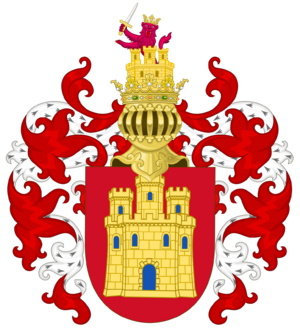
In heraldry, a crest is a symbol placed on top of a helmet, usually above the shield. The Royal Crest of Castile, also called the Crest of the Castle and the Lion, was used by the last kings and queens of Castile and Spain until the 1800s. This crest showed a castle with a lion rising out of it. These two figures are the main symbols from the Royal arms of the Crown of Castile.
King John II (who ruled from 1406 to 1454) started using this crest. It appeared on coins made in Seville and in his portraits. Before this, Castilian monarchs sometimes used a crest with a gold griffin (a mythical creature with the body of a lion and the head and wings of an eagle).
The Spanish kings and queens from the House of Habsburg also kept the royal crest. By the early 1500s, the lion in the crest started to be shown crowned, holding a sword and a globe with a cross on top. Kings Philip II and Philip III even added two more crowned helmets with dragons, representing the crests of the Portuguese and Aragonese monarchs. They always made sure the Castilian crest and arms were in the most important, central position.
Because the Castilian symbols were always given the main spot in the Spanish royal arms, the Royal Crest of Castile became seen as the crest for all of Spain. However, after the 1700s, full royal symbols were used less often, and the castle and lion crest almost disappeared until the Spanish monarchy was brought back in 1975.
Supporters are figures or objects placed on either side of the shield, appearing to hold it up. Lions were sometimes shown supporting the arms of the Castilian king, starting with King John II. These lions were used as supporters until the reign of Philip V and in some detailed versions of Spain's national arms after 1868.
-
Coat of Arms of John II and Henry IV with Supporters
-
The Castilian arms with the Crest of the Castle and the Lion. During the reign of John II the royal crest was represented over the Device of the Bend depicted on a shield
-
Full armorial achievement of the Monarch of Spain since Charles III with the Crest of the Castle and the Lion
Castilian Flags
During the Middle Ages, flags and banners were not always made in a single, standard way. There wasn't one official design for a Castilian royal flag. The designs of the castle or the colors of the fabric could change depending on the person making them or what was popular at the time. These flags came from showing the Castilian king's arms on cloth. They became symbols of the Kingdom and the Historic Region of Castile. The background color was usually red or a deep red (crimson).
-
Flag of the Autonomous Community of
Castile and León
(1983-) -
Flag of the Autonomous Community of
Castile-La Mancha
(1986-)
Flags with a three-towered castle on red or crimson fabric were used by Castilian monarchs. The quartered design of Ferdinand III (castle and lion) was also used on his flag. This design is the basis for the current flags of the Spanish regions of Castile and León and Castilla-La Mancha.
There was some confusion that led to a legendary "Castilian banner" being purple, even though no such flag has ever been found or proven. This idea influenced the flag of the Second Spanish Republic, which had a purple stripe. This confusion might have come from how crimson fabric can fade over time to look purple. It also relates to a legend about a purple flag used during a revolt against King Charles I in the early 1500s. Today, some groups that support Castilian nationalism use a purple flag with the castle, and some Castilian Leftist groups use the castle inside a red star.
See also
 In Spanish: Heráldica de Castilla para niños
In Spanish: Heráldica de Castilla para niños
- Royal Bend of Castile, a special flag of the monarch of the Crown of Castile
- Castile
- Old Castile and New Castile
- Crown of Castile
- Kingdom of Castile
- Castilianism
- Coat of arms of Castile and León
- Coat of arms of Spain
- Coat of arms of Portugal
- Royal Arms of England
- Flag of Castile and León
- Quartering (heraldry)
- Heraldry of León
- Spanish heraldry


